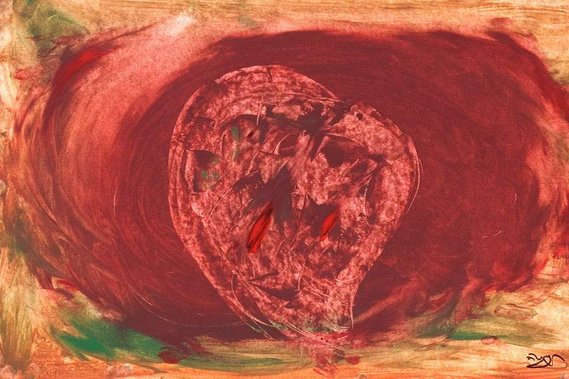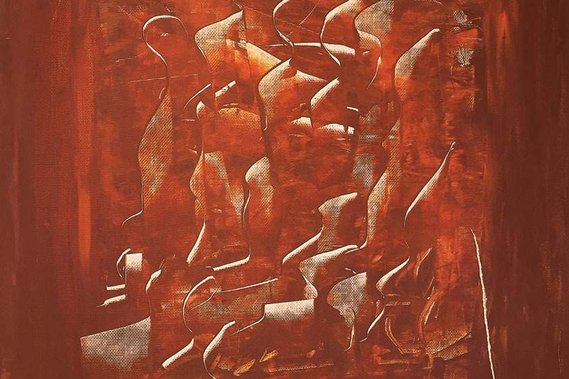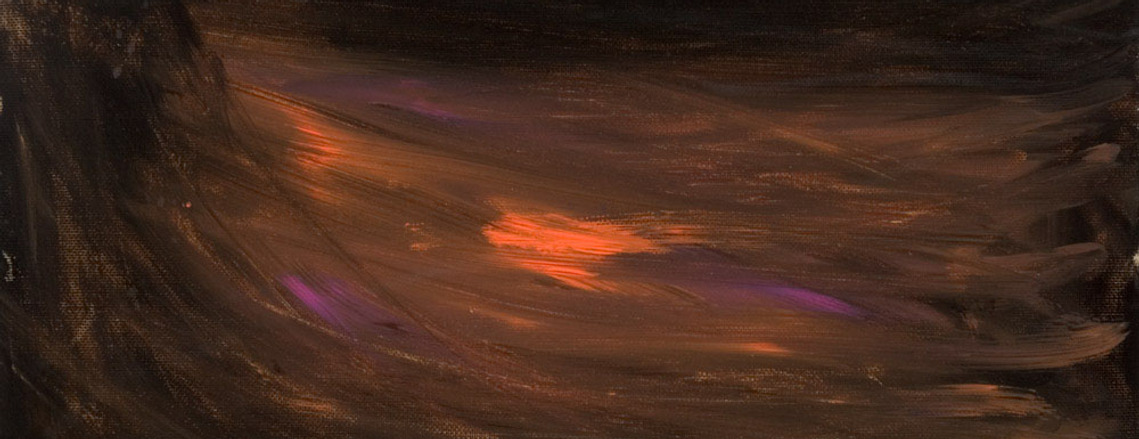Artist's Forward from Light Coming Through:
The Mark of Non-Creating
Kongtrul Jigme Namgyel
For me, painting is a means to express the truth one discovers through meditation. The essential practice of meditation is to allow the mind to express itself freely without fear or judgment. In each moment of awareness we encounter impressions of the outer world through our sense perceptions as well as our inner world of thoughts, feelings and emotions.
When we are able to let this incredible array of experience be, without trying to reject what we fear or pull in what we are attracted to - when we relax into experience without trying to manipulate it in any way - we have a complete experience of mind, naked and unaltered. Painting, when it is free of such notions as beauty and ugliness or should and shouldn't, can be used to express this complete experience of mind. When art evolves from this understanding it provides the possibility for those who see it to also experience the unfabricated nature of their own mind.
For an artist such as myself who is a Vajrayana practitioner, abstract art presents a great opportunity to test the mind with the view of "one taste." In the tradition of Vajrayana Buddhism ro-chik or one taste is the ability to experience and appreciate all aspects of mind without judgment. This view does not deny the variety of experience; it does not reduce all colors to grey or all experience to some vague or bland neutrality; nor does it ignore the importance of our discriminating intelligence. It simply points to the fact that when we put to rest our conventional notions of good and bad, desirable or undesirable, we can see things as they are without the veil of concepts. We can see the world in a direct and fresh way.
When I bring the view of ro-chik to my painting, there is no sense of being attached to good art or good creation. Not that attachment doesn't arise - as I work whatever struggles and challenges exist in my mind become apparent. But my discipline is to go beyond attachment, to transcend fixed mind, to not get stuck. This kind of openness and honesty moves me through habitual mind and helps me rise above my fixations. There is appreciation for whatever arises that goes beyond the ordinary notions of our preferences - we don't cling to beauty when we are not seeing it as "beautiful as opposed to ugly." When I appreciate all expressions of mind in this way, I see anything I create as a result of a natural process. This is ro-chik in action. Light with darkness, small mind with big mind; abstract with form, form with formlessness; movement of the mind within the bigger view of absolute space - I simply observe all of this, in the mind and also in the art. Throughout this process my mind remains relaxed and open. Everything is accepted as art. There is no stickiness due to biases or judgments. To transcend fixations in this way is the opportunity that combining art with practice provides.
The joy, the delight, to play! And allowing oneself to freely abide in the discipline of non-attachment runs through the work as a theme. In this freedom I still try to capture something from deep within, encountering it through the movement of what's in front of me on the canvas. The colors, turpentine, paper, texture, the movement of my strokes, mixed with my perceptions and presence of mind come together naturally. I try to let this whole process happen on its own, I cannot single handedly make all the moves. It is a matter of stepping aside and letting it happen. Then what I create, I simply leave it at that and am content, however uncomfortable or raw the painting may be.
In order to transcend fixations, whether in art or meditation, I believe you have to start with a foundation of discipline. Traditionally, most painters begin their training with basic forms and skills, which provide this necessary background. They learn to draw and paint according to someone else's skills, or established forms, adopting these common, fundamental methods as their own. In my observation, however beautiful what you create out of those basic skills and methods may be, over time you begin to recognize a limitation to your own creativity. You find that you are not free to completely embody your own creativity, in whatever form it may arise. Embodying your own creativity without restriction is where an artist thrives; it is how he or she becomes whole as an artist, in my opinion.
Many modern artists, particularly the abstract expressionist painters, sought out the means for their creativity to emerge from their discipline more and more fully over time, cherishing that raw creativity as essential to their art. They tried to paint as freely as possible, without structure or form, letting their feelings lead the development of the work. In their fruition as artists, they transcended their discipline, coming to a more free, expressive and nonconceptual place. I appreciate this work very much because in it I see a parallel to the practice of meditation.
In the beginning of your meditation practice you study the teachings and meditate according to the methods they present. You also emulate how people in the past have worked with their minds, thoughts and emotions, doing your best to embody the path as they have. Initially your meditation is conceptual, which is a necessary aspect of the training, much in the same way that painters begin using established methods. But over time this rigorous discipline trains your mind, attuning it to its inherent abilities and fundamental nature. At some point you begin to see through the concepts that originally shaped your meditation, and you step out of reliance on methods and the example of others.
There has to be this transition where you actually become yourself fully, and simply relate to your mind and emotions and thoughts very freely and directly. Whatever comes up in your experience becomes part of this non-conceptual meditation practice; the variety of your experience enhances your practice furthermore.
After abandoning all guidelines and concepts, one rests in the inherent awareness of the mind. This awareness is traditionally described as "unaltered" or "un-fabricated" because it is not subject to your preferences and judgments, nor to any concepts of meditation or beliefs about how the mind should be. It is simply the freedom to experience mind and the world in the most direct and alive way.
From this perspective, a limitless variety of thoughts and emotions can enter your awareness; there is nothing blocking them. And there is no need to grasp onto them either. Rather, you accept all that arises as an expression of mind's natural creativity. Your discipline becomes simply to "stop creating" and let things be.
As a painter, when I am able to completely step out of the way, based on my meditative discipline, this is the mark of non-creating; this is when I stop producing. Whether the work appears "finished" or "unfinished," what is happening on the canvas at that moment is not the point; it is more a matter of what is happening inside, which in turn determines when I put my brush down. The mark of non-creating is the mark of natural expression. It is the signature of what I value in my life and work.




